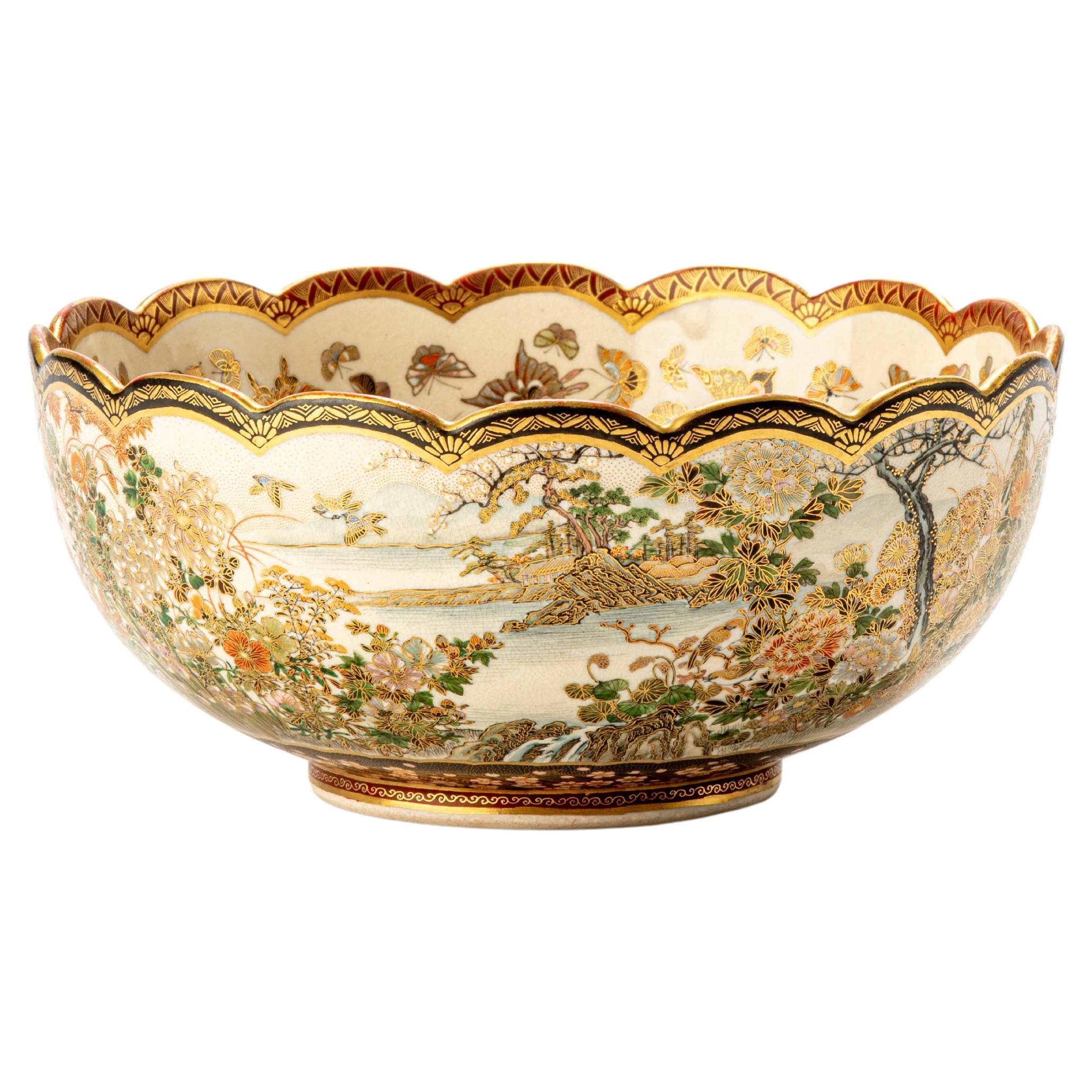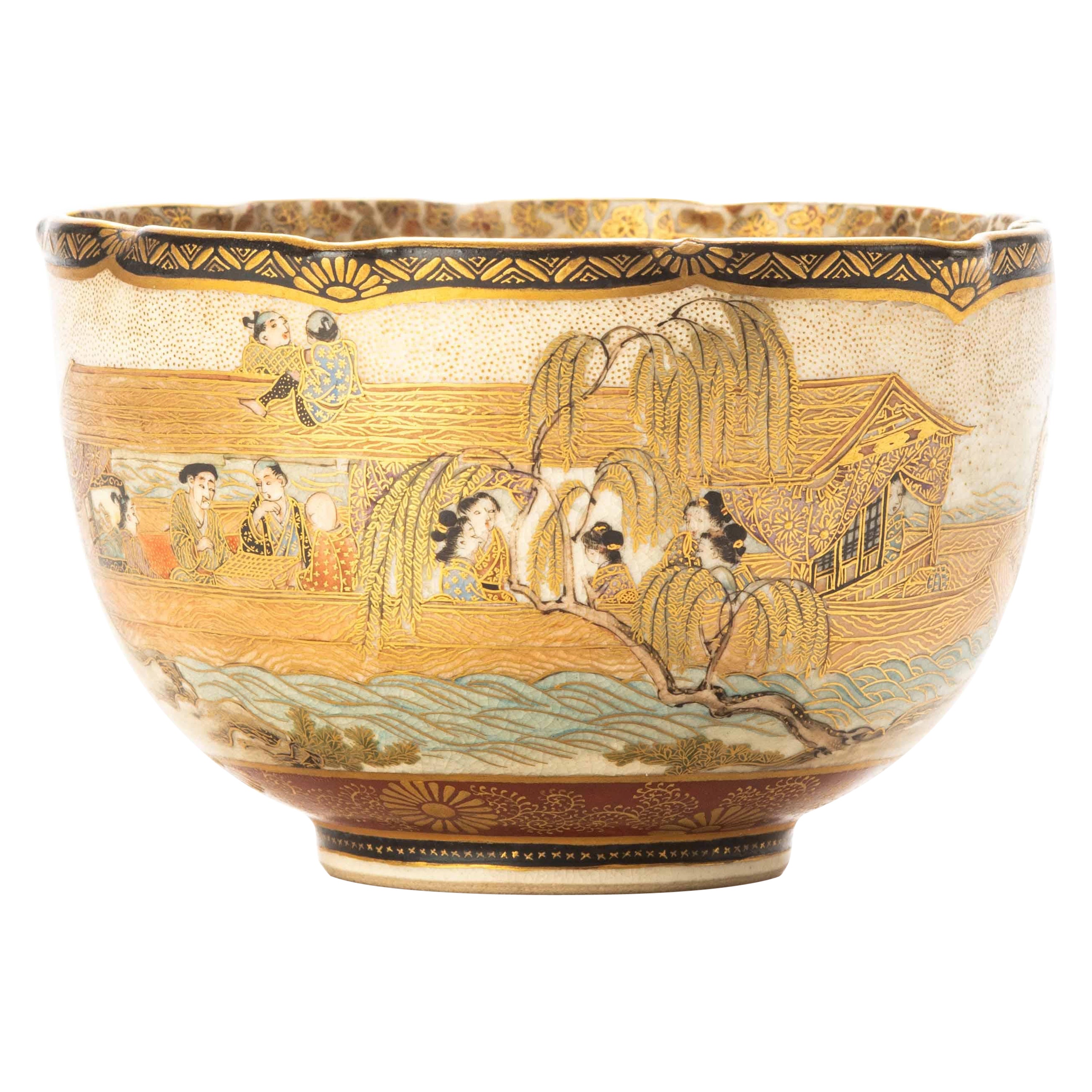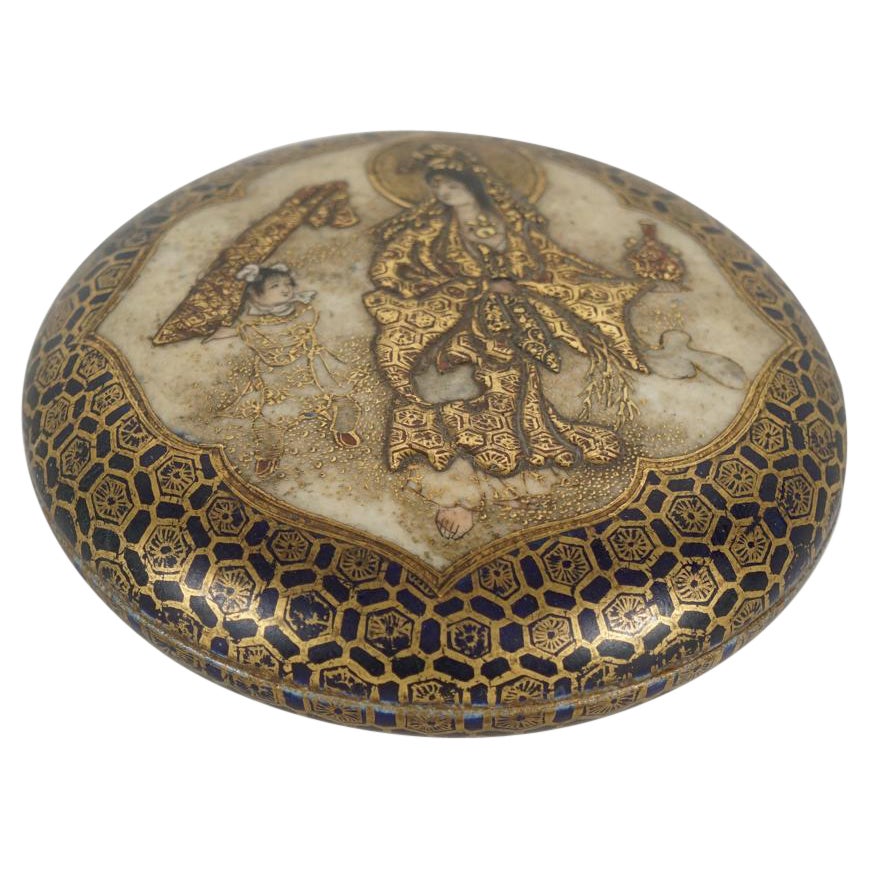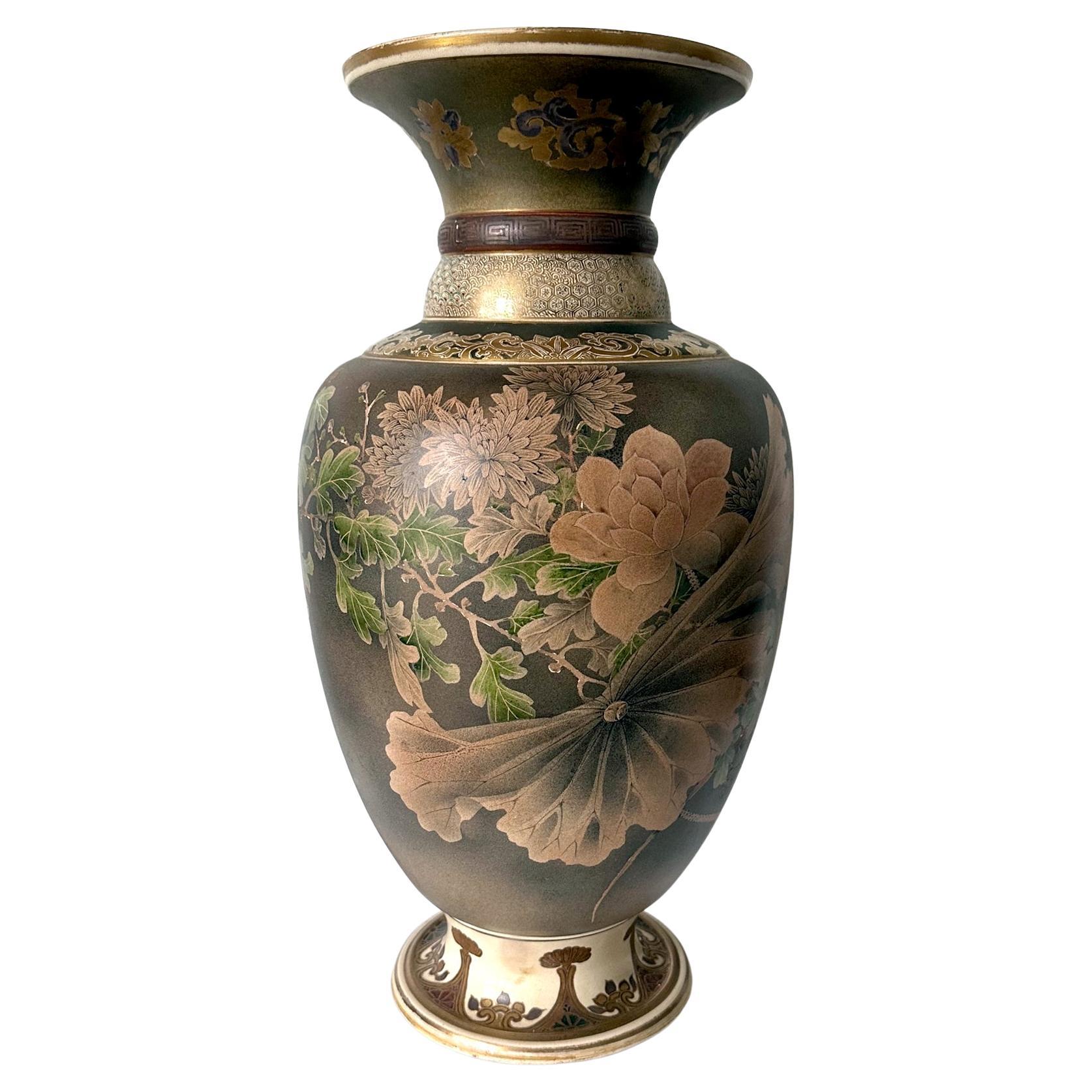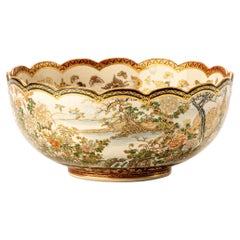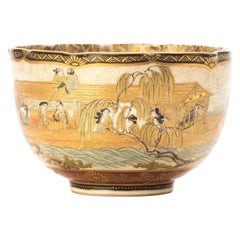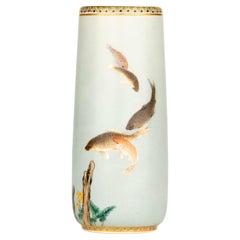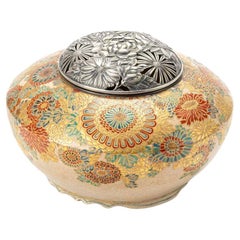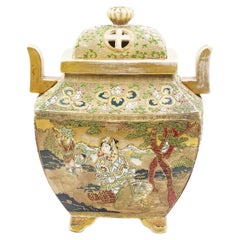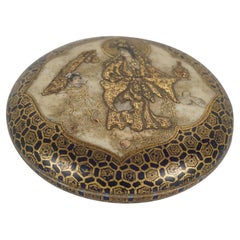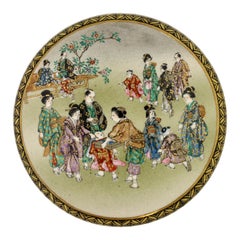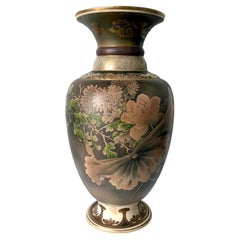Items Similar to A Satsuma ceramic box in the shape of a hamaguri shell
Want more images or videos?
Request additional images or videos from the seller
1 of 7
A Satsuma ceramic box in the shape of a hamaguri shell
$2,398.36
£1,784.14
€2,000
CA$3,284.17
A$3,651.55
CHF 1,906.64
MX$44,448.29
NOK 24,327.89
SEK 22,794.07
DKK 15,224.90
Shipping
Retrieving quote...The 1stDibs Promise:
Authenticity Guarantee,
Money-Back Guarantee,
24-Hour Cancellation
About the Item
A Japanese Satsuma ceramic box modeled in the shape of a hamaguri shell (a Japanese clam traditionally associated with themes of union), featuring a gilt crab as a handle.
The exterior is decorated in polychrome enamels and gold with floral motifs and chidori (plovers).
The interior is adorned with two fan-shaped reserves, each with floral decorations, surrounded by flying butterflies.
The box rests on two small feet.
Period: Meiji, late 19th century
Dimensions: 14 x 20 x 18 cm
Condition: Excellent
- Dimensions:Height: 5.52 in (14 cm)Width: 7.88 in (20 cm)Depth: 7.09 in (18 cm)
- Materials and Techniques:
- Place of Origin:
- Period:
- Date of Manufacture:Meiji late 19th cent.
- Condition:
- Seller Location:Milano, IT
- Reference Number:1stDibs: LU9162246044572
About the Seller
No Reviews Yet
Recognized Seller
These prestigious sellers are industry leaders and represent the highest echelon for item quality and design.
Established in 2012
1stDibs seller since 2023
Typical response time: 4 hours
- ShippingRetrieving quote...Shipping from: Milano, Italy
- Return Policy
Authenticity Guarantee
In the unlikely event there’s an issue with an item’s authenticity, contact us within 1 year for a full refund. DetailsMoney-Back Guarantee
If your item is not as described, is damaged in transit, or does not arrive, contact us within 7 days for a full refund. Details24-Hour Cancellation
You have a 24-hour grace period in which to reconsider your purchase, with no questions asked.Vetted Professional Sellers
Our world-class sellers must adhere to strict standards for service and quality, maintaining the integrity of our listings.Price-Match Guarantee
If you find that a seller listed the same item for a lower price elsewhere, we’ll match it.Trusted Global Delivery
Our best-in-class carrier network provides specialized shipping options worldwide, including custom delivery.More From This Seller
View AllSatsuma ceramic lobed bowl, signed Juzan under the base
Located in Milano, IT
Satsuma ceramic lobed bowl adorned with raised enamels and fine gold details, depicting a vibrant landscape within. Characters and traditional Japanese home...
Category
Antique Late 19th Century Japonisme Ceramics
Materials
Ceramic
$3,165 Sale Price
20% Off
A Japanese Satsuma ceramic lobed bowl
Located in Milano, IT
Satsuma ceramic lobed bowl with curved corners and embellished with a refined scene of daily life along a watercourse on the outside. The interior is adorne...
Category
Antique Late 19th Century Japanese Japonisme Ceramics
Materials
Ceramic
$3,261 Sale Price
20% Off
A Satsuma Vase Depicting A Group Of Carp Swimming In A Stream
Located in Milano, IT
A Satsuma vase depicting a group of carp swimming in a stream. The scene is depicted from a shore perspective, where partially submerged tree trunks emerge and delicate flowers bloom...
Category
Antique Late 19th Century Japanese Japonisme Ceramics
Materials
Ceramic
$3,981 Sale Price
20% Off
A Japanese Satsuma Gosu blue ceramic koro decorated with chrysanthemums
Located in Milano, IT
A Japanese incense burner (koro) in Satsuma ceramic, in the Gosu blue style, decorated with a rich composition of chrysanthemums in full bloom.
The flowers are painted using enamels...
Category
Antique 19th Century Japanese Ceramics
Materials
Ceramic
$1,726 Sale Price
20% Off
A Large Satsuma Vase Depicting A Scene Of Daily Life
Located in Milano, IT
Large cylindrical Satsuma vase, decorated with polychrome enamels and pure gold, depicting a scene of daily life with three geishas and a samurai on a festive day.
Signed ‘Seizan zō...
Category
Antique Late 19th Century Japanese Japonisme Ceramics
Materials
Ceramic
$4,029 Sale Price
20% Off
Large Satsuma vase featuring representations of nobles and children
Located in Milano, IT
Large Satsuma vase with two reserves, separated by elegant floral and geometric decorations: one depicts scenes of nobility with daimyo and samurai, the other celebrates childhood wi...
Category
Antique Late 19th Century Japanese Ceramics
Materials
Ceramic
$1,726 Sale Price
20% Off
You May Also Like
Koro Satsuma Japanese ceramic
Located in Buenos Aires, Argentina
Koro Satsuma Japanese ceramic
Japanese glazed ceramic in various colors
Meiji Style Circa 1940 Origin Japan
It has traditional images painted on its front and back.
The purpose of th...
Category
Vintage 1940s Japanese Meiji Ceramics
Materials
Enamel
Meiji Period Satsuma Patch Box
Located in Hudson, NY
This small detailed work made between 1890 and 1900 is skillfully painted representing a court lady in regal costumes being attended to by a small child carrying a bolt of silk cloth. This centered in a medallion where the raised decoration is heavily embellished with gold and patterned details. The round outer area is done in a cobalt blue with more goldwork designs and the interior of the box holds small painted objects as symbols of refinement and or beauty. The box is signed by the painter's hand but as yet we have not translated or matched it to a specific maker's work.
Wares of this type are most often produced in the city of Kagoshima in Kyushu province during the Meiji period and reflects the export industry designed to cater to western tastes but not particularly bought by Japanese citizens.
Patch boxes...
Category
Antique Late 19th Century Japanese Ceramics
Materials
Ceramic
Satsuma Earthenware Covered Box, by Kinkozan
By Satsuma
Located in West Palm Beach, FL
A Satsuma Earthenware covered box,
by Kinkozan,
Japanese, Meiji period (1868-1912)
decorated in polychrome enamels and gilt over a clear, crackled glaze, delicately painted with s...
Category
Antique Early 1900s Ceramics
Materials
Earthenware
Large Japanese Satsuma Ceramic Vase Kinkozan
By Kinkozan
Located in Atlanta, GA
A large Japanese ceramic vase from the end of Meiji period circa 1890-1910s by Kinkozan (1645-1927). One of the largest studio manufacturers of the export ceramics at the time based in Kyoto. In the typical style of satsuma made at the turn of 20th century, the vase is elaborately decorated with a rather unusual kinran-de (gold paint) and green enamel highlight on a mottled brown background. The painterly decoration depicts a large seasonal floral arrangement in a circular fashion. Besides the obviously superb craftsmanship, what sets this particular vase apart from many lower quality and mass-produced pieces is its tone-on-tone color pallet that is visually somber and the small and sensitive details that heralds the change of the seasons. When the viewer goes beyond the first casual glimpse of the blossom and foliage, one would notice that on the edges of certain leaves as well as along the stalks, there accumulates a very thin layer of the white dust that represents the frost. The flower in bloom are chrysanthemums. Despite of being splendid, they are the messengers of the autumn. The large lotus leaf was subtly rendered in a bended and slightly withered manner, just past its prime. Although the lotus is still in bloom, the prominent seed pod indicates it may be the last for the season. The sentimental capture of the change of the seasons is not unusual in Japanese art. This vase poetically represents such a subtle transition from summer to fall, perhaps depicting the very first frost.
The neck of the vase is also slightly unusual with two rolled rings...
Category
Early 20th Century Japanese Meiji Ceramics
Materials
Ceramic
Japanese Satsuma Ceramic Ewer Yabu Meizan
By Yabu Meizan
Located in Atlanta, GA
A Satsuma ware miniature ewer from the studio of Yabu Meizan (birth name Yabu Masashichi; 1853-1934), who was one of the most celebrated and collectible Satsuma artists from the Meij...
Category
Early 20th Century Japanese Japonisme Ceramics
Materials
Ceramic
Antique 19C Japanese Satsuma High Quality Vase in Pipe Shape with Flowers
Located in Amsterdam, Noord Holland
Description
A Faboulas Japanese Satsuma vase, Meiji period
-----------------------------------------------------------------------------------------------------------------
Co...
Category
Antique 19th Century Japanese Meiji Ceramics
Materials
Porcelain
$861 Sale Price
20% Off

